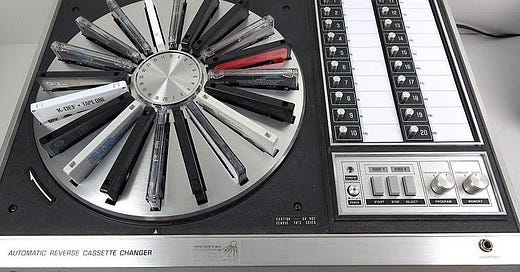I came across the Techmoan YouTube channel, run by a fellow named Mat Taylor, only around last Thanksgiving, but it’s quickly become one of my favorite sources of old tech history and trivia. One of my recent articles was inspired by one of his videos, on the Sony Digital Audio Tape and a war with the American recording industry.
A major appeal of these videos to me, particularly the ones which feature older, somewhat complicated devices, is the evident craftsmanship and solidity of products that were nonetheless mass-produced and consumer grade.
Here are a couple I really like. This first one is still consumer grade but is very high end. It’s a tuner combined with an oscilloscope, which was used in some stereo components as a way to essentially visualize and calibrate the sound (unnecessary for the vast majority of hi-fi owners, but apparently useful for making sure everything was working just right.)
This other one is rare today, and innovative, but not a particularly high-end product. It’s a carousel-based cassette tape changer, a type of device which never took off, probably due to its complexity and expense.
These two videos feature absolutely gorgeous, exquisitely well-designed devices, from long enough ago that they’re still full of metal mechanical parts as well as electronics. It’s funny how quickly the American attitude toward Japanese electronics whiplashed from deriding them as junk to fearing them as competition. Believe it or not, as late as 1975, it was possible for Walter Matthau, in The Sunshine Boys, to say of Japan, “They lost the war, now they send us their junk!” Jingoistic Americans back then would have never foreseen that “Made in Japan” would soon become a virtual byword for quality. (The SAE oscilloscope/tuner may have been made in the U.S., although at least some of their products were made in Japan. I wasn’t able to track down the country of origin for this particular model, and it isn’t stamped on the back.) The Panasonic, of course, was both designed and manufactured in Japan, as were most or all products from Japanese companies like Pioneer and Technics (and Marantz, another American company which went over to Japanese manufacturing).
There’s something wonderfully calming about watching these solid decades-old devices come to life and function properly—and to be able to roughly understand how they’re operating. I’m fascinated by the thought that this stuff was mass produced within living memory, and yet the art and craft of it, the industrial ecosystem of tool and die and machine shops, designers, prototypers, and the large number of corporations that had the engineering capacity to produce products of this caliber in-house is pretty much lost. We’re not talking about Egyptian pyramids or Roman roads or medieval automata. We’re talking about stereo systems that were, in some form, in a majority of American homes throughout the second half of the 20th century.
In one of the comments on the SAE video, somebody says that the oscilloscope seemed alive. I understand the idea that there’s something tactile and warm about analog, and cold and distant about digital. That isn’t really true of the sound, no matter what vinyl audiophiles say (it was true of the first generation of CD players; it’s actually the case that CD playback quality can differ by machine). But this notion of analog is absolutely, obviously true of the engineering and the technology. Modern electronic devices have a black-box feel to them; what’s actually going on inside is impossible for the average person to understand or intuit. I’m sure the complexification of consumer goods has some effect on how our minds and ways of thinking develop.
I am Catholic, and I get a similar feeling watching that Panasonic cassette changer mechanism in action as I do attending Mass. I don’t mean that there’s any ultimate, metaphysical significance in an old tape player. What I mean, I think, is that I feel there is some importance in keeping alive even the pedestrian and ordinary pieces of our cultural history. There are so many laborious man-hours embedded in that device, so many centuries of slowly accumulated ingenuity and mechanical knowledge. Almost sacramental. Part of the appeal of Catholicism for me is its tradition and its ritual, the sense that being Catholic is taking part in something across time. I’m sure history buffs and Civil War reenactors feel something similar. Is it weird that a Japanese cassette changer from 1972 hits those same buttons for me?
Maybe. So what?




Loved this. I reflected on the attractions of analogue tools and my 1989 Sony Walkman here: https://mattcivico.com/manual-competence-analogue-limits/
I've found Ivan Illich to be a helpful guide on these questions!